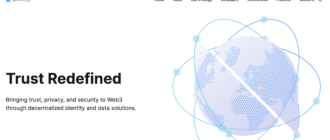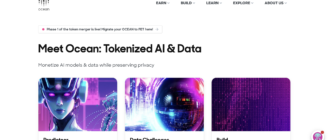Cosmos stands out in the crowded blockchain landscape for its pioneering vision to solve one of the most pressing issues in blockchain technology: interoperability. By enabling different blockchains to communicate and exchange data seamlessly, Cosmos aims to create an “Internet of Blockchains.” This vision is powered by a series of unique technological solutions, which are crucial for understanding the project’s potential and appeal.

History of the Project
Cosmos was born from the whitepaper published in 2016 by Jae Kwon, who introduced the fundamental ideas of consensus through Tendermint and the vision of interoperable blockchains. The project officially launched with its mainnet in March 2019. Since its inception, Cosmos has been developed by the Tendermint Inc team, which also played a pivotal role in the creation of the Inter-Blockchain Communication (IBC) protocol, one of the core components of the Cosmos network. The project has since seen significant milestones, including multiple upgrades to enhance network functionality and security.
What is Cosmos?
Cosmos is designed as a decentralized network of independent parallel blockchains, each powered by classical Byzantine fault tolerance (BFT) consensus algorithms like Tendermint. The primary purpose of Cosmos is to address the scalability and interoperability issues that plague traditional blockchain systems. It allows various blockchains not only to coexist but to interact in a decentralized manner, paving the way for a scalable and interoperable ecosystem.
How Cosmos Works?
Cosmos is built on a series of sophisticated and purpose-specific technologies, each designed to address specific challenges faced by blockchain networks, such as scalability, usability, and interoperability. The distinguishing features of Cosmos stem from its unique approach to network architecture, consensus mechanism, and a development framework that facilitates blockchain innovation.
Blockchain Structure
At the core of Cosmos is a hub-and-spoke model wherein the Cosmos Hub connects various independent blockchains called “zones.” Each zone maintains its sovereignty, meaning it operates independently with its governance and blockchain but can interact with other zones through the Cosmos Hub. This structure allows for specialized, optimized blockchains that can scale and evolve without congesting the main network, thereby overcoming a common limitation in earlier blockchain designs.
Consensus Mechanism
Cosmos utilizes Tendermint BFT (Byzantine Fault Tolerance), a consensus mechanism designed for speed, security, and network consistency. Tendermint BFT is a leader-based protocol where a validator node is chosen to propose a block, and other validators participate in a multi-round voting process to finalize each block. This method offers several advantages:
- Quick finality: Once a block is committed, it cannot be reverted, which is crucial for transactions that require finality, such as financial operations.
- Security: It can tolerate up to one-third of failing or malicious nodes without compromising the integrity of the network.
- Performance: Tendermint can process thousands of transactions per second, depending on the network conditions and transaction complexity.
Differentiation from Other Projects
Unlike many blockchain solutions that focus on providing a single blockchain with various features, Cosmos stands out by promoting blockchain diversity and connectivity. Its architecture supports an expanding ecosystem of interoperable blockchains, each optimized for specific needs yet capable of communicating through the Cosmos Hub. This design philosophy addresses the “one size fits all” issue prevalent in earlier blockchain projects, where increased network load could lead to significant congestion and higher transaction fees.
In summary, Cosmos is not just a blockchain; it is a framework for building an interconnected ecosystem of blockchains. Its use of Tendermint BFT for consensus, combined with the modular Cosmos SDK for blockchain development and the innovative hub-and-spoke architecture, positions Cosmos uniquely in the blockchain space. These technologies support its vision of an “Internet of Blockchains,” where diverse blockchain applications can operate independently yet interoperate seamlessly through a standardized communication protocol.
What is Cosmos SDK?
Cosmos SDK is a flexible, open-source framework designed to simplify the process of building secure, scalable, and interoperable blockchain applications. Positioned at the core of the Cosmos network, it serves as the standard development toolkit for creating decentralized applications and custom blockchain protocols within the Cosmos ecosystem.
Purpose and Core Features
The primary goal of Cosmos SDK is to enable developers to create blockchain applications that can operate either independently or as part of the larger Cosmos network. It achieves this by providing developers with a modular architecture that allows them to use pre-built components or develop new modules to extend the functionality of their blockchains.
Key features of the Cosmos SDK include:
- Modularity: The SDK is built on a modular design that allows developers to plug in ready-made modules for various blockchain functionalities like governance, staking, and token management. This modularity also facilitates the development of custom modules tailored to specific needs, enhancing flexibility and efficiency in blockchain development.
- Scalability: By decoupling the application layer from the consensus layer, the Cosmos SDK enables blockchains to execute transactions in parallel, significantly increasing throughput and efficiency.
- Interoperability: Designed to support the Inter-Blockchain Communication (IBC) protocol, the SDK allows the blockchains built with it to communicate and exchange data with other IBC-compatible chains in the Cosmos network. This promotes a network of interconnected blockchains, facilitating seamless value transfer and data sharing across diverse platforms.
- Security: The SDK encourages a security-first approach to development. It is built on top of Tendermint Core, which provides a robust and secure consensus mechanism based on Byzantine Fault Tolerance (BFT). This setup not only secures the network against various attack vectors but also ensures quick transaction finality.
Architectural Components
The architecture of Cosmos SDK consists of several core components:
- Baseapp: This is the foundation upon which each blockchain built with the SDK operates. It handles routing and processing of transactions and manages the state of the blockchain.
- Tendermint Core: Integrated directly with the SDK, Tendermint handles network consensus and ensures that all transactions on the blockchain are immutable and securely added to the blockchain.
- Modules: These are the building blocks of any blockchain developed with the SDK. Common modules provided by the Cosmos SDK include
Authfor authentication,Bankfor token management, andGovernancefor handling proposal and voting mechanisms.
Use Cases and Applications
The Cosmos SDK is versatile enough to accommodate a variety of blockchain applications. Examples of platforms built using the Cosmos SDK include:
- Binance Chain: Developed for handling asset trading and management on the Binance decentralized exchange.
- Terra: Although reformed after its collapse, originally used the SDK for its stablecoin and synthetic asset platform.
- Thorchain: Employs the SDK to facilitate decentralized crypto asset exchange through cross-chain liquidity pools.
The Cosmos SDK stands as a cornerstone technology within the Cosmos ecosystem, providing the necessary tools and infrastructure for building advanced, interoperable, and scalable blockchain solutions. Its design philosophy and robust toolkit support the Cosmos vision of an interconnected “internet of blockchains,” where diverse blockchain applications can operate seamlessly together.
Tokenomics of Cosmos
The ATOM token functions as more than just a digital currency within the Cosmos network; it serves as a pivotal element in the network’s governance, security, and operational frameworks. ATOM is a cryptocurrency, but its role extends into a utility and governance token, making it a cornerstone of the Cosmos ecosystem.
Nature of ATOM: Token or Coin?
ATOM is technically a coin because it is used as the native asset on its blockchain, the Cosmos Hub. As a coin, it facilitates various network operations, including paying for transaction fees and participating in the consensus mechanism through staking. The distinction between a token and a coin is significant, as coins are associated with a blockchain while tokens are typically built on existing blockchains. ATOM’s integral role in the Cosmos Hub’s functionality categorizes it firmly as a coin.
Emission Model and Supply Dynamics
Cosmos adopts an inflationary model for ATOM, where new coins are minted as part of the network’s staking reward mechanism. The inflation rate is adaptive, designed to encourage participation in the network’s staking process; it adjusts based on the total percentage of ATOM staked. If the staking ratio falls below a target threshold (currently around 66%), the inflation rate increases to incentivize more users to stake their coins. Conversely, if the staking ratio is high, the inflation rate decreases. This dynamic approach helps maintain network security and compensates validators and delegators for the risks and costs of locking up their tokens.
Token Circulation and Price Dynamics
As of the last analysis, the total supply of ATOM is not capped, which supports the adaptive inflation mechanism. The circulating supply adjusts according to staking engagements and the inflationary or deflationary pressures dictated by network activities. The price of ATOM, like most cryptocurrencies, is subject to market conditions influenced by factors such as network adoption, overall crypto market trends, and investor sentiment. It also reflects the perceived value of the Cosmos network’s capacity to offer interoperability and scalability solutions.
Economic Role and Utility
ATOM holders have significant influence within the network. They can vote on governance proposals, which dictate the future development, technical adjustments, and ecosystem improvements. This governance function is crucial for a decentralized network like Cosmos, where strategic decisions are made collectively by its community. Furthermore, by staking ATOM, users contribute to network security. Validators are chosen based on the amount of ATOM they hold and the staking decisions of other token holders, creating a meritocratic system.
The ATOM tokenomics are thus characterized by a blend of utility in governance, incentives for network security, and an adaptive economic model that aims to balance supply with demand. This structured approach ensures that ATOM remains integral to Cosmos, not just as a currency, but as a tool for broader community engagement and network development.
Where to Buy the ATOM?
The ATOM coin can be purchased on several leading cryptocurrency exchanges that offer robust trading options, liquidity, and security measures. Here are some notable platforms where ATOM is available:
- Binance: One of the largest and most well-known cryptocurrency exchanges in the world. Binance offers a wide range of trading pairs for ATOM, including against fiat currencies and other cryptocurrencies.
- HTX (formerly Huobi): Known for its service reliability and substantial market depth, HTX provides another robust platform for buying and trading ATOM.
- MEXC: Offers competitive trading fees and good liquidity, making it a suitable option for trading ATOM especially in Asia.
- Bybit: Known primarily for derivatives trading, Bybit also offers spot trading for ATOM, catering to both beginner and experienced traders.
- KuCoin: Popular among international users for its wide range of cryptocurrencies, including ATOM, KuCoin is known for easy-to-use features and various user-friendly trading services.
- Bitfinex: With a long-standing position in the cryptocurrency market, Bitfinex provides advanced trading features and high liquidity for trading ATOM.
Before trading or buying on any exchange, it’s important to consider factors like trading volume, security features, user interface, and support services to ensure a safe and convenient trading experience.
Where to Store the ATOM Coin?
When it comes to storing ATOM, users have several options that provide different levels of security and functionality. Here’s a list of wallets suitable for storing ATOM:
- Ledger Wallet (Hardware): Ledger provides one of the most secure ways to store ATOM coins. As a hardware wallet, it keeps your private keys offline and protected from online threats. Ledger supports ATOM staking directly from the wallet interface.
- Trezor (Hardware): Another secure hardware option, Trezor, allows ATOM holders to safely store their coins, with the added benefit of integrating with wallet interfaces that support ATOM staking.
- Cosmostation (Mobile and Web): Cosmostation is a multi-functional wallet app specifically designed for the Cosmos network. It supports both mobile and web platforms, offering features like staking, governance participation, and transaction history.
- Keplr Wallet (Browser Extension): Keplr is a browser-based wallet that provides a convenient interface for managing ATOM and interacting with the Cosmos ecosystem directly from your web browser. It supports staking and participation in network governance.
- Atomic Wallet (Desktop and Mobile): This wallet offers a user-friendly solution for those who prefer managing their ATOM on desktop or mobile devices. Atomic Wallet also supports staking and has an internal swap feature for exchanging ATOM with other cryptocurrencies.
Choosing the right storage for your ATOM coins depends on your needs for security, convenience, and additional functionalities like staking and governance. Hardware wallets are best for high security, while mobile and web wallets offer more convenience and direct interaction with Cosmos network features.
Future Prospects and Development Forecast
Growth Drivers
The growth of Cosmos is primarily driven by its foundational technology that promotes interoperability and scalability through a modular framework. The project’s ability to attract new blockchains into its ecosystem by offering easy integration and robust security through the shared security model is a key advantage. Furthermore, the continuous development of the Cosmos SDK and improvements in the Inter-Blockchain Communication (IBC) protocol are central to its expansion, as these technologies lower the barriers for blockchain development and foster a thriving network of diverse chains.
Clients and Partners
Cosmos has garnered attention and collaboration from a wide array of blockchain projects and enterprises, which contribute to its robust ecosystem:
- BNB Chain: A notable partner that has developed its own blockchain using the Cosmos SDK, enhancing the stature and credibility of Cosmos.
- Terra: Before its collapse, Terra utilized the Cosmos SDK for its blockchain solutions, showcasing the adaptability of Cosmos technology.
- Crypto.com: Leverages the Cosmos technology to run its blockchain, increasing the transaction capacity to meet its growing user base’s needs.
- Thorchain: Uses Cosmos to create a decentralized liquidity network, allowing cross-chain token swaps without relying on external parties.
- Akash Network: An innovative cloud computing marketplace built using Cosmos, demonstrating the versatility of the Cosmos SDK.
These partnerships not only validate the technical capabilities of Cosmos but also enhance its visibility and adoption across different blockchain applications.
Development Forecast
Looking ahead, Cosmos is expected to continue focusing on enhancing its IBC functionality, which is pivotal for maintaining and expanding its position as a leader in the interoperable blockchain space. The upcoming developments are likely to attract more decentralized finance (DeFi) applications, enterprise blockchain solutions, and independent dApps seeking efficient cross-chain communication. Additionally, ongoing efforts to improve user and developer experiences could significantly influence adoption rates, further propelling the ecosystem’s growth.
The Cosmos Ecosystem
The ecosystem surrounding Cosmos is rich and varied, encompassing a wide range of projects that utilize its technology:
- Sentinel: A decentralized VPN service providing secure and private internet access.
- Regen Network: Focuses on environmental monitoring and data services.
- Persistence: Aims to bridge traditional finance with DeFi through a suite of financial products.
- Kava: A cross-chain DeFi platform offering collateralized loans and stablecoins.
These projects illustrate the flexibility and capability of the Cosmos network to support a broad spectrum of blockchain applications, reinforcing its foundational premise as the “internet of blockchains.”
In summary, the future development of Cosmos looks promising, with substantial technological innovations on the horizon and a growing list of partners and projects within its ecosystem. The ongoing expansion into new areas of blockchain applications and consistent improvements to its core technology are likely to keep Cosmos at the forefront of blockchain interoperability solutions.
Conclusion
Cosmos represents a significant leap towards achieving a decentralized and interoperable blockchain ecosystem. With its robust technological foundation and strategic vision, Cosmos is poised to play a pivotal role in the future of blockchain technology. As such, it presents a compelling case for advanced users and investors looking to capitalize on innovative blockchain technologies and their long-term strategic potential.






